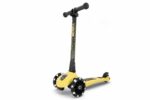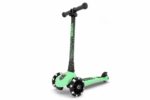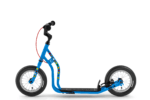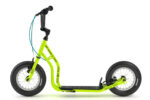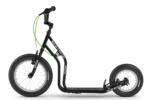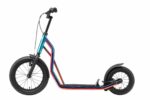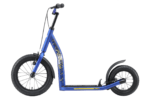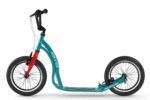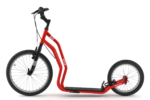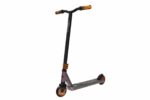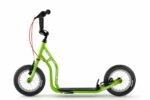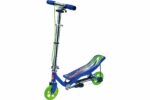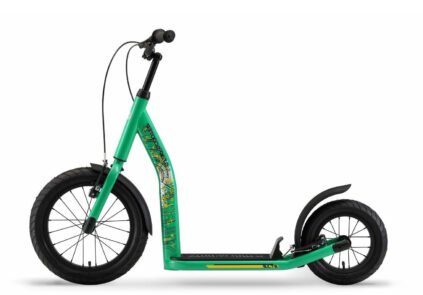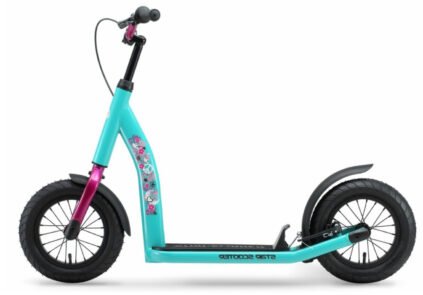Kids scooters are the perfect introduction to the world of children's vehicles
Kids scooters are the ideal means of transport for young children. Because the feet are close to the ground, your child can easily jump off the scooter if things get dicey. A child on a scooter can thus catch itself much better than when it is on a bicycle.
Children learn to keep their balance in a safe way. For the very young, there are also scooters with 3 wheels. With these scooters, your child is particularly stable on the ground. An ideal support for children who are just taking their first steps on a scooter.
Training of motor skills and coordination
Even the youngest children of 2 years learn to stand quickly on the scooter. When your child is on the move with the scooter, it simultaneously trains the brain, motor skills, balance and coordination. Estimating speeds and distances is also automatically trained in this way.
Content
- Training of motor skills and coordination
- Wheels on a children's scooter - where are the differences?
- Scooters for children from about 2 years
- Scooters for children from 3 years
- Scooters for children from 4 years
- Scooters for children from 5 to 6 years old
- Kids scooters for children from 7 to 8 years
- Kids scooters for children from 9 to 10 years
- Scooters for teenagers
- Wheels, front fork and weight on a stunt scooter

What types of children's scooters are there?
Kids scooter are available in four different designs or types. In our shop there is a wide range of scooters with Pneumatic tyres, scooters with hard plastic tyres or Stunt scooters.
The various types of children's scooters differ considerably in terms of their features and the materials used in their manufacture. The following table shows you the most important differences between the various types of children's scooters:
| Scooter type | Kids scooter | Infant Scooter | Scooter | Stunt–Scooter |
| Frame material | Steel o. Aluminium | Steel o. Aluminium | Steel o. Aluminium | Aluminium |
| Number of wheels | 2 | 3 or 4 | 2 | 2 |
| Wheel size | 12 to 16 inch | up to 120 mm | 80 to 200 mm | up to 120 mm |
| Wheels | Pneumatic tyres | Hard plastic or PU wheels | PU wheels | PU wheels |
| height-adjustable handlebar | Yes | Yes | Yes | No |
| Foldable frame | mostly not | Yes | Yes | No |
| Brakes | Rim brakes | none o. Friction brake | Friction brake | Friction brake |
| Running board material | Wood or plastic | Plastic | Aluminium | Aluminium |
Wheels on a children's scooter - where are the differences?
Children's scooters are available with different wheels. In addition to the age of the children for whom the scooter is built, the intended use of the scooter. It also plays a role in which wheels it is equipped with. You get children's scooters with:
- Hard plastic wheels
- PU wheels
- Pneumatic tyres
Children's scooter with hard plastic wheels
Hard plastic wheels are practically only found on children's scooters for the very young. Hard plastic wheels often slide over the ground more than they roll and the driving noise is very loud. In the meantime, manufacturers have started to equip children's scooters for toddlers, such as the Scoot and Ride Highwaykick 1, with PU wheels.
Scooters for children with PU wheels

Today, normal scooters and stunt scooters are practically all equipped with PU wheels. PolyurethanePU is a very durable plastic that is resistant to damage from sharp objects. In addition, PU offers minimal damping while driving. The rolling noise is also very quiet. Because of their often small diameter, these scooters are particularly suitable for flat surfaces such as smoothly asphalted pedestrian paths or the pedestrian zone.
Kids scooter with pneumatic tyres
The pneumatic tyres for kids scooters are basically small bicycle tyres. They are usually mounted on a metal spoke rim. They offer a certain level of suspension comfort and a very quiet ride. Because of the larger diameter, children can also ride over smaller obstacles such as flat kerbs or similar relatively safely with a pneumatic tyre scooter.
Which kid scooter is suitable for which age?
Many children can and want to start riding a scooter from the age of one and a half to 2 years. Often, a scooter is bought in addition to a running bike. In the following sections, we will show you which children's scooter suits which age from toddler to teenager and how to find the ideal children's scooter for your child.
The requirements for kids scooters change with age. In the beginning, the stability of the scooter is in the foreground. Therefore, scooters with 3 wheels are the best choice for toddlers. When the children are about 4 years old and have reached a height of at least 1 m, you can switch to larger scooters. Of course, it is also an advantage that the children can already ride safely on a smaller scooter. For older children, the focus is on the fun of riding.
In the following, we have compiled for you which children's scooter is suitable for which age:
Scooters for children from about 2 years
As soon as your children can walk safely on their own, they can also ride a children's scooter. The earliest age is about one and a half years. Most children are ready when they are 2 years old. Optimal for the beginning are 3- or 4-wheeled children's scooters such as the Scoot and Ride Highwaykick 3 LED from our shop. Due to the two front wheels, this children's scooter offers a secure stand. This is important because a toddler aged one and a half to two years first has to learn to keep his balance. Your child also has to train the coordination of arms and legs. It is very important for a children's scooter that the handlebars can be adjusted to the optimal height. For a toddler, it should be possible to adjust the handlebars of a scooter to about waist height plus a few centimetres. At this height, a toddler can control the scooter well.
Also interesting for a toddler is the Scoot and Ride Highwaykick 1 from our online shop. This children's scooter can be easily converted into a running bike with seat in just a few steps. A running bike like YEDOO ONETOO A treadmill is generally a very suitable means of transport for a toddler from about 2 years of age. Even small children can keep their balance well on a treadmill and move relatively quickly. The YEDOO ONETOO running bike is available in our online shop with and without a handbrake. For the Yedoo TOO TOO running bike, a suitable Carrying strap available for easy transport when your child is exhausted and can no longer continue on their own.
Scooters for children from 3 years
For a toddler of 3 years, there is also still a three-wheeled Scooters for children recommendable. These scooters for children are suitable for the beginning as well as when your child wants to switch from a running bike to a scooter. Because of the comparatively large front wheels for a toddler scooter, these children's scooters are also suitable for riding on somewhat uneven surfaces. Children can ride over low edges, such as pavement slabs or cross grooves, almost effortlessly with this scooter. A scooter for children over the age of 3 should be as light as possible. If cornering does not quite work yet, children can simply lift the scooter up and move it to continue in the right direction. It is also essential that the handlebars of a scooter for children over 3 years of age can be adjusted to the right height for optimal control.

Scooters for children from 4 years
In a way, 4 years is the most difficult age to find the right children's scooter. Difficult not in the sense that children at the age of 4 have greater difficulty learning to ride a scooter. What is difficult is choosing the right type of scooter at this age. The most important criterion is not the age per se, but how far your child has already developed physically. For a toddler of 4 years old, a two-track scooter may still be advisable. For most four-year-olds, however, a two-wheeled scooter is absolutely suitable. It depends on the dexterity and above all on the body size.
Older children of this age can usually ride a scooter as easily as a primary school child. Of course, you should also pay attention to the weight of the scooter. A scooter for 4-year-olds should still be as light as possible so that your child can lift and move the scooter without any problems. Since a scooter can easily reach higher speeds, you should show your child how to brake and practise braking extensively. Maybe you have the opportunity to let your child try out one or the other type of scooter at a neighbour's house. Then you can see which scooter for children is the right one for your offspring.
Scooters for children from 5 to 6 years old
A scooter or a pedal scooter with pneumatic tyres is suitable for 5- or 6-year-old boys and girls of the appropriate size. Scooters like the JD BUG JUNIOR MS 100 have the advantage that they are relatively light and can usually be folded up. A scooter with pneumatic tyres for a primary school child like the YEDOO NEW TIDIT or the YEDOO NEW MAU is heavier in comparison and usually cannot be folded. Another advantage of these scooters is that the air-filled tyres absorb shocks during the ride, increasing riding comfort and protecting your child's joints. The footboard of a scooter with pneumatic tyres is usually wider than that of a scooter, so that your children can safely stand on it with both feet.
A scooter for boys and girls aged 5 to 6 years should definitely be equipped with a height-adjustable handlebar. This way, you can adjust the height of the handlebar to the size of your child as he or she grows. Your child can use the scooter for many years and has better control over the scooter with an optimally adjusted handlebar. We recommend the following for scooters with pneumatic tyres such as the YEEDO ONE from our online shop to buy mudguards. These scooters for children are usually not equipped with mudguards. Also a Bell must not be missing. As with a kickbike for adults, you can also buy a good battery-powered LED light as an accessory for a children's scooter.
Kids scooters for children from 7 to 8 years
From the age of 7 at the latest, most girls and boys have outgrown the two-track children's wheels. Now you have the choice between a scooter and a children's scooter with pneumatic tyres. 7 years is also the age from which children can ride a stunt scooter in the skate park. A recommendable children's scooter with pneumatic tyres is, for example, the YEDOO NEW TIDIT with pneumatic tyres of the same size and a rim brake on the rear wheel. Also the YEDOO NEW WZOOM with a 16 inch front wheel, a 12 inch rear wheel and rim brakes on both wheels is well suited for this age. An air pump is recommended and indispensable for a scooter with pneumatic tyres. Either one Mini air pumpwhich you can comfortably take with you everywhere in a backpack, or a floor pump such as the JOE BLOE SPORT AIR PUMPYou can keep them handy in the garage, for example.
Kids scooters for children from 9 to 10 years
At the age of 9 to 10 years, your children are able to ride and control practically every scooter. At this age, the scooter is often more of a useful transport device than a toy. At the age of 9 to 10, they can usually already ride a stunt scooter very well. But a normal scooter like the JD BUG JUNIOR MS 100, which is available in many different colours in our online shop, or a scooter with pneumatic tyres are also ideal scooters for boys and girls at this age.
Scooters for teenagers
Teenagers are usually already very independent. They know what they want. This is also reflected in the choice of scooter. From the age of 11 to 12, depending on their height, teenagers can already ride a kickbike built for adults. For example the KICKBIKE FREERIDE G4. The FREERIDE kickbike is extremely robust and can be used by a teenager for off-road rides, trips with friends or parents and at the skate park. Recommended accessories for a children's scooter with pneumatic tyres are a Stand from our range of accessories. Of course, teenagers still have fun with a stable Stunt scooterthat can do almost anything. In the following section, we will show you the difference between a stunt scooter and a normal scooter.
Kids scooters vs. stunt scooters - what's the difference?
Children's scooters and stunt scooters are hardly distinguishable from each other at first glance. Both have the same size and are basically built the same way. The differences only become apparent at second glance.
The first major difference is that a stunt scooter cannot be folded. Children's scooters are equipped with a joint between the footboard and the handlebars so that the scooter can be folded up to save space for transport in the car or on the bus. On a stunt scooter, this joint is omitted for stability reasons. The reason for this is that the joint is always a weak point on a stunt scooter. During jumps and tricks, this joint is subjected to a great deal of stress, fails over time and can even break apart under very high loads. A scooter that is collapsible is therefore never a real stunt scooter. An example of a very stable stunt scooter for boys and girls from about 7 to 8 years old is the JD BUG 119T Stunt Scooter from our online shop. The JD BUG 119T stunt scooter has no joint and cannot be folded. In contrast, the JD BUG JUNIOR MS 100 is a typical children's scooter that can be folded and ridden by a primary school child. For a toddler, these Kids scooter but still too big.

Wheels, front fork and weight on a stunt scooter
A stunt scooter does not have pneumatic tyres. Like a children's scooter, a stunt scooter is equipped with the PU wheels that come from inline skates. However, the rims of the stunt scooter wheels are not made of plastic, as is usually the case with a normal scooter, but of Aluminium manufactured. Aluminium rims are very light and much more robust than plastic rims. They can withstand the stresses of jumps and tricks for a long time. The front fork of a stunt scooter is usually more massive than that of a normal scooter for children because of the high load.
A stunt scooter should be light and robust at the same time. A low weight makes it easier to control the scooter when doing tricks on the ramp or jumping. A high level of robustness is required to withstand impacts when landing after a jump. Because of their above-average robustness, stunt scooters are usually somewhat heavier than normal scooters. The solid workmanship is not the only reason why the price for a stunt scooter is higher than for a normal scooter. Also the high-quality Ball bearing of the wheels are partly responsible for the higher price.
If you value a stable and long-lasting Scooter then a stunt scooter is definitely the right choice for you. You or your children can ride a stunt scooter just like a normal scooter. The advantage: When the opportunity arises, your children can let off steam without having to worry that the scooter will fall apart after the first jump.
What brakes do children's scooters have?
Scooters for a toddler from about 1.5 years old are often made without brakes. A brake is not necessary because of the low speed. Also, very few toddlers would manage to brake the scooter because the coordination of hands to steer and feet to push off and brake is still too difficult for them.
Many children's scooters, for example normal scooters and stunt scooters, are equipped with a so-called friction brake. With this type of brake, the mudguard of the rear wheel is used for braking. It is pressed onto the rear wheel with one foot while riding and thus brakes the wheel. When the foot is lifted, a spring pulls the plate back from the wheel so that it can roll freely again. These brakes have the advantage that if the brakes are applied too hard, the wheel only locks but the children's scooter cannot roll over. A friction brake can often only be used properly by a primary school child.
Children's scooters with pneumatic tyres are often already like scooters for adults with Rim brakes equipped. Some children's scooters with pneumatic tyres only have a rim brake on the rear wheel. Others are also equipped with a rim brake on the front wheel. If the scooter you have chosen has a rim brake on the front wheel, you should show your child how to brake with this brake without the front wheel locking and the scooter rolling over if necessary.
Learning to ride a kids scooter
Even the smallest ones can learn to ride a children's scooter. In the beginning, two-track scooters with three or four wheels like the Scoot and Ride Highwaykick 3 LED from our online shop are really recommendable. On atwo-track scooter for children a toddler can first stand safely without having to keep his balance. They can concentrate on pushing the scooter with one foot. The handlebars on a scooter for a toddler are initially more for holding on to than for steering. In any case, you should always be there when your child is trying to ride the scooter for the first time. Never leave your child unattended at the beginning.
With a lot of patience, show your child how to hold on and how to push himself off with his feet. A toddler learns fastest through imitation. If you yourself, older siblings or children in the neighbourhood ride a scooter, then not only will the desire for their own scooter be expressed sooner or later, learning to ride a children's scooter will also become child's play through imitation.
The ideal place to learn how to ride children's wheels is a short mown lawn, which should not be too soft. The terrace or garage driveway are also suitable. It is very important that the surfaces are absolutely smooth and free of edges or other tripping hazards. It won't take long before your child can coordinate steering, pushing off with his foot and looking where he is going. Don't try to show your child everything at once. You really need to be patient. Then everything will come naturally and your child will keep enjoying riding the scooter.
If your child is already a little older, for example a primary school child, then you can start learning to ride with a scooter or another children's scooter that is suitable in size. You won't have to explain much to children aged 5 or 6. They have seen often enough how their playmates ride a scooter. They will simply take the scooter, get on and ride off.
What equipment do children need when riding a scooter?
Children's scooters basically have the advantage over children's bicycles that the feet are not far from the ground. In case of insecurity, children can therefore get off quickly and stand safely on the ground. In any case, you should protect your child with a suitable helmet. Although the riding speeds are still slow at first, a fall can still lead to serious head injuries. We therefore appeal to all parents to always provide their children with a Helmet to put on.
When it comes to wearing a helmet, children always look at what their parents show them. Whether your child wears a helmet or rejects it depends primarily on your behaviour as a role model. If you wear a helmet yourself, your child will usually want to wear one too. If you don't wear a helmet when riding a scooter, your child will most likely refuse to wear a helmet. As soon as
If your child is out and about in the dark or at dusk, it is also advisable to use a Lighting to the children's scooter. There are also LED helmet lights, which can be attached directly to the helmet. It is also recommended that your child wears clothing with reflectors.
If your child is riding a stunt scooter, he or she should definitely wear protectors, as the risk of injury is significantly increased when practising tricks and jumps. But children on normal scooters also minimise the risk of injury by wearing protectors.
Once your child has mastered the scooter for children, you will sooner or later want to go on longer tours. From this point on, it is advisable to at least equip your child's helmet with a Helmet light to equip your scooter. You should purchase suitable lighting for yourself and your scooter. A Bell for your child's scooter is also recommended.
Where are children allowed to ride a scooter?
According to § 24 StVO, children's scooters and scooters that are not driven by a motor are considered special means of transport, just like inline skates. They are not vehicles in the sense of the Road Traffic Act. This means that the same regulations apply to children's scooters as those specified in § 25 StVO for pedestrians. Children may only ride a children's scooter or scooter on pavements. Riding in a pedestrian zone or a play street is also permitted with these pedal scooters. However, cycle paths and roads are taboo for these scooters. Only if there is no pavement next to a road may these vehicles also be ridden on the road.
What does a children's scooter cost?
The price for a very solid children's scooter for a toddler, which you can fold up and convert into a running bike, is around 80 to 100 euros. The price of a normal scooter for a primary school child starts at around 50 euros. A stunt scooter is a little more expensive, costing between 80 and 150 euros. A scooter with pneumatic tyres that a teenager or primary school child can ride costs around 120 to 250 euros. The price can vary depending on the brand and equipment of the scooter.

